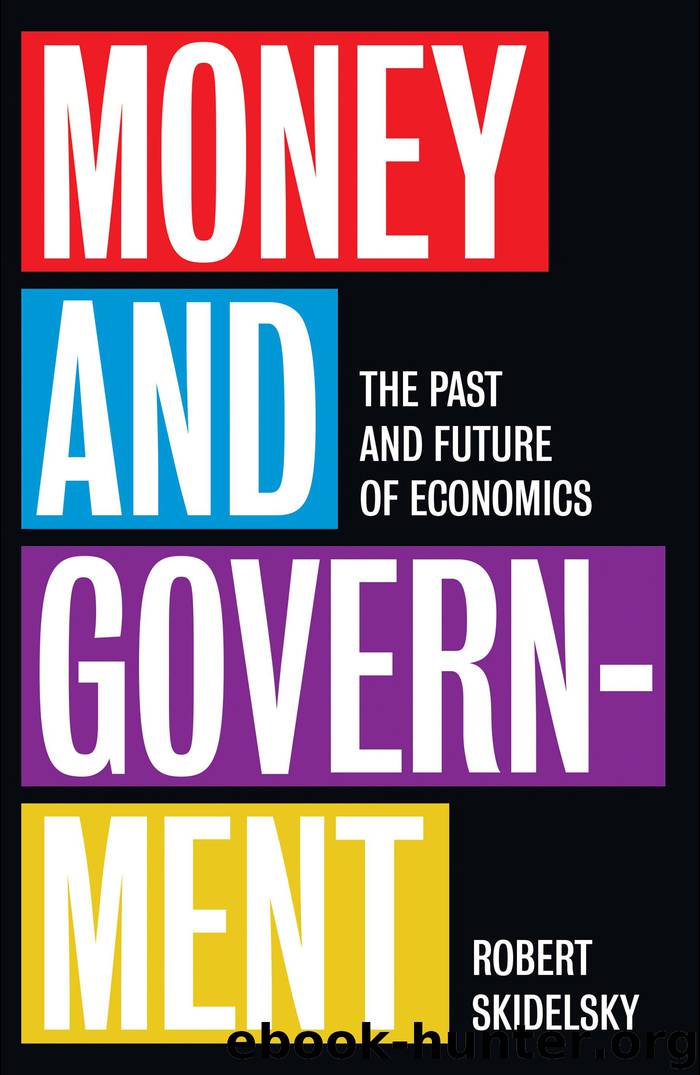Money and Government: The Past and Future of Economics by Robert Skidelsky

Author:Robert Skidelsky [Skidelsky, Robert]
Language: eng
Format: epub
Tags: Business & Economics, Economic History, Economic Policy, Foreign Affairs, Macroeconomics, Political Science, Politics & Government, Public Policy, Theory
ISBN: 9780300240320
Google: Uh5zDwAAQBAJ
Amazon: 0300240325
Publisher: Yale University Press
Published: 2018-11-13T00:00:00+00:00
Figure 36. Post-crash outcomes: Germany, Greece and Eurozone47
Figure 37. UK austerity – counterfactual medicine48
Simon Wren-Lewis of Oxford University calculates the cost of austerity up to 2017 as between £4,000 and £13,000 per household.49 As for workers, the situation was worse still. Ninety per cent of the population have not had a pay rise for ten years, and household debt is back to its pre-crash level.
IV. CONCLUSION
One might be tempted to conclude that the debate between the Keynesians and the Osbornians, like the confrontation between Keynes and Sir Richard Hopkins before the Macmillan Committee in 1930, resulted in no clear-cut victory for either side. Osborne could (and did) argue that GDP had recovered to its pre-crash level by 2013–14, that Britain now had full employment, and that the public finances were relatively sound. In other words, the Keynesian contention that, in the absence of a stimulus, the British economy was bound to remain in semi-slump, had no foundation. Automatic recovery forces and the confidence-raising effects of austerity were enough to lift the economy out of slump territory. In different words, there were no multipliers to be had from fiscal stimuli.
However, this conclusion would be wrong, for three reasons. First, it does not acknowledge that the return to growth in mid-2009 was not ‘automatic’, but was the result of the Keynesian measures taken in Britain and elsewhere to stimulate the economy. The reversal of these measures in Britain did not ‘restore’ growth; it was accompanied by a reduction in growth by an estimated 1 per cent a year between 2010 and 2015.50
Secondly, all competent authorities agree that fiscal contraction delayed recovery, slowed down growth and destroyed growth potential. Headline unemployment in Britain has fallen to just under 5 per cent, the lowest since 1975, but this excludes the millions of part-time workers who say they would work full-time if they could, those forced into precarious self-employment and on to zero-hour contracts, and those over-qualified for the jobs they do. The vaunted flexible labour market revealed by the recession has delivered a sizeable ‘jobs gap’. If we take just two categories – those claiming unemployment benefit and those of the employed who say they would work longer hours if such work was available – about 11 per cent of the British workforce is ‘under-employed’.51 The opportunity to use available labour and cheap borrowing costs to build infrastructure was ignored: only 105,000 houses were built in Britain in 2011, the lowest number since the 1920s.
Thirdly, fiscal austerity was partly offset by monetary expansion and a fall in the sterling exchange rate. This is in line with the view that fiscal contraction in a recession need not cause a decline in aggregate demand, if there are offsetting forces of demand expansion. Still, the stagnation of 2010–12 suggests that the theory linking fiscal tightening to recovery is wrong. It was based on the careless view that a reduction in public spending is the same thing as a reduction in the deficit. But if the reduction in
Download
This site does not store any files on its server. We only index and link to content provided by other sites. Please contact the content providers to delete copyright contents if any and email us, we'll remove relevant links or contents immediately.
The Secret History by Donna Tartt(16611)
The Social Justice Warrior Handbook by Lisa De Pasquale(11486)
Thirteen Reasons Why by Jay Asher(7783)
This Is How You Lose Her by Junot Diaz(5755)
Weapons of Math Destruction by Cathy O'Neil(5032)
Zero to One by Peter Thiel(4818)
The Myth of the Strong Leader by Archie Brown(4787)
Promise Me, Dad by Joe Biden(4441)
Stone's Rules by Roger Stone(4413)
Beartown by Fredrik Backman(4406)
How Democracies Die by Steven Levitsky & Daniel Ziblatt(4393)
The Fire Next Time by James Baldwin(4338)
100 Deadly Skills by Clint Emerson(4072)
A Higher Loyalty: Truth, Lies, and Leadership by James Comey(4028)
Rise and Kill First by Ronen Bergman(4009)
The David Icke Guide to the Global Conspiracy (and how to end it) by David Icke(3876)
The Farm by Tom Rob Smith(3870)
Secrecy World by Jake Bernstein(3774)
The Doomsday Machine by Daniel Ellsberg(3726)
